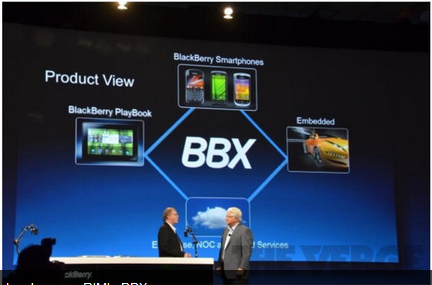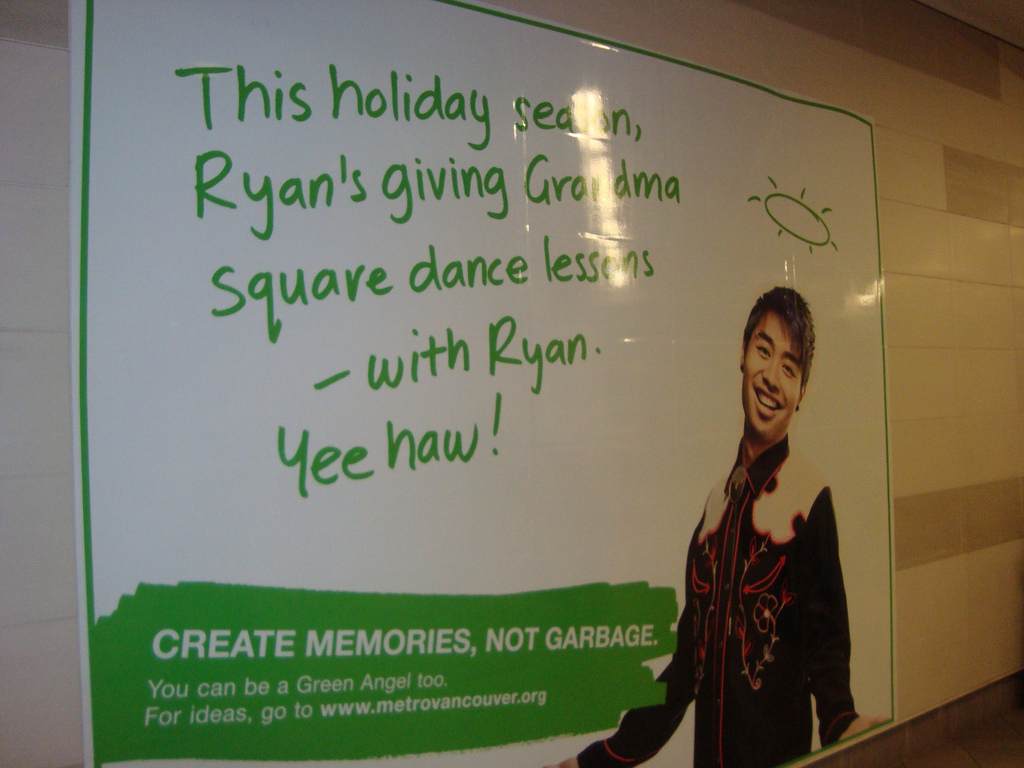A company flailing its arms and latching onto anything…
Taylor Carter titled his post on February 8th as “Superior Features Don’t Always Win” and I think he’s right. Taylor talked a bit about Blackberry vs. iPhones in his post and I’d like to focus the subject of my post on RIM.
RIM is a company that has been talked about so much it’s old. When it’s brought up in casual conversation, it is met with a roll of the eyes, a breath and a sigh. But as a Blackberry user who still has a tinge of affection for my smartphone, I’d like to talk about the desperation I see within RIM.
The newest update about RIM? Nothing much other than what can be summarized in this article in the Vancouver Sun. I quote:
RIM rolled out the full version of its BlackBerry Mobile Fusion platform – which allows corporate BlackBerry networks to manage Apple Inc. devices such as the iPhone or iPad as well as Google Inc. Android-based devices – the same day the company was hit with yet another lawsuit and a report saying BlackBerry’s anemic share of the United States smartphone market is still bleeding out.

In February 2010, RIM held 42% of the smartphone market in the US. By November 2011, this became 16.6%. By February 2012, this was 13.4%. This decision to let in other mobile platforms seems to me that RIM is letting go. The smartphone industry is one that is predicated upon exclusivity – that my app store has more apps, that no one else has BBM or that my multitouch screen is superior. It may not be too far to suggest that RIM is divesting it’s smartphone operations. It seems like RIM has finally decided that they’re good at security and the business platform and finally focused on it.
But they aren’t.
BB10, RIM’s next Blackberry platform is a source of confusion. This article tries to explain some of the BB10 features. Most important points? Blackberry won’t run Blackberry apps. No, they won’t. Instead, they will run Android apps. But not all apps will transfer over. What a confusing message – even more confusing in light of Blackbery’s Mobile Fusion announcement.
What is RIM trying to do? Remember, only less than a year ago this was the message that RIM was sending out:

If there is one thing we learned about promotions in Marketing, it’s coherency, consistency and integration. No matter what the promotional channels, there has to be one message. But for RIM, there is no single message to be understood. For an individual, confidence can mean a lot when no one else believes in your idea. The same concept applies to a company – RIM just looks desperate right now. And it shows. No, superior features won’t always win, but never mind winning, first set yourself up to win.
Green – the DNA of your supply chain
With the GLOBE 2012 conference in full blossom this week at our very own Vancouver Convention Centre, it’s hard for me not to talk about business environmental sustainability in this post. I mean – there needs to be some way for me to vent my excitement for some of the workshops I’ve sneaked into as a volunteer and there’s no better way to do it than here. Laura’s blog on greenwashing focused on what companies said they were doing but were not actually doing, but I would like to focus on the exciting things that are being done by businesses to address environmental responsibility. Today, I’m going to focus on green supply chains. How do we along each step of a product’s life – from production to transportation to the end user – reduce environmental impact? This video offers a brief introduction:

While this video gets us thinking about how far each of our products have come along, it doesn’t address how businesses might go about reducing their environmental impact. Turns out greening a supply chain isn’t all that complicated, it comes down to squeezing more value out of current operations. 
As the above image shows, most sustainable activities for businesses start with compliance. Regulatory measures only take businesses so far though as businesses start to view supply chain sustainability as a key competitive advantage. As Dave Meyer explains in his blog, the ISO 14001-2004 certification is becoming the industry standard in determining marketing channel partners in the risk of losing customers and increasing costs.
IBM is an example of a company that pushes the envelope even more. In Andrew Winston’s blog, he introduces the Electronics Industry Code of Conduct (EICC) and IBM’s initiatives to mandate its marketing channel partners to adopt environmental measures.
In short, IBM is asking for four things and telling suppliers they must:
- Define and deploy an environmental management systems (EMS).
- Measure existing environmental impacts and establish goals to improve performance.
- Publicly disclose their metrics and results.
- “Cascade” these requirements to any suppliers that are material to IBM’s products
This culminates to the costly venture of life cycle analyses of each and every product. This means tracking the footprint of every step of a product and by measuring, being able to measurably improve environmental impact. Apple has already done this and reported on their results:
Andrew Winston ends his post by saying:
IBM execs know that the green path is a profitable one, so they’re pushing suppliers to operate leaner, better, and smarter. As Balta says, “Our goal is not to punish people, but to have them succeed.
My wish is for this to ring true with all businesses in the near future.
Add your voice – mindcheck.ca

As mentioned in my first blog post, I am deeply passionate about marketing for social good. Effective marketing has the ability to generate a lot of clout, communicate important messages to a large audience and more importantly, garner collective action from individuals. I encountered one campaign of such this weekend: mindcheck.ca
MindCheck is a website and a campaign that aims to raise awareness about mental distress, especially those experienced by young individuals. Unlike the traditional Kids Help Line or Youth Crisis Lines, MindCheck has its inspiration from a community hero: former Canucks player Rick Rypien who has battled depression and committed suicide this summer in his home in Alberta. Kevin Bieksa, to whom Rick first confided his difficulties, uses his influence as a Vancouver icon to promote this website, encouraging young individuals to seek help. Below is an interview of Kevin Bieksa speaking about the difficulties Rick faced.

From a marketing perspective, mindcheck.ca is very effective.
It stems from the story of a community hero who we can identify with and another fellow Canuck who has helped his friend battle mental distress first hand. These stories are altering the perception from the times when openly speaking of mental distress was a sign of weakness to demonstrating an encouraging and supportive environment.
It’s stylish website is designed with its target audience in mind.
On it’s front page is a photo of seemingly ordinary young individuals. When one puts a mouse pointer above these individuals, thought bubbles pop up (shown above) with mental distress-related thoughts of these individuals. Stylishly and in a subtle way, 37 RYP is incorporated and the graffiti asks a thought-provoking question of “ever wonder”. The website is not text heavy nor overbearing, keeping the barrier for individuals to use this website relatively low.
Finally, social media has been used effectively in this program. Clicking on 37 RYP on the front page will link individuals to a tool where users can record their own video messages to post on Facebook and Twitter about their pledge to combat mental illnesses. Here’s mine! http://mindcheck.ca/inonevoice?vid=425
All in all, by making this my blog post for my assignment, I hope you can spread the word about this important issue as well.
Is there a better way to demonstrate value?
In a world where we shut off the traditional marketing means of billboards, newspaper ads and TV commercials …
Also a world where we think Facebook ads, Google Search ads are slightly creepy …
How are businesses able to get our attention in a honest and truthful way? Well, Ikea has a great idea. Watch the video below:
So Ikea decides to build and furnish a 54 square metre amount of space at a Paris metro station and gets 5 volunteers to move in and live there for a week. A simple, yet brilliant idea. A couple reasons why:
Ikea plays on the innate curiosity within all of us – instead of forcing ourselves to ignore advertising messaging, we will actively seek out this live advertisement because it’s cool.
Ikea really is able to demonstrate the value of their products. Instead of looking like delicate displays under the spotlight in a typical Ikea showroom, their furniture undergoes the test of space and use in the tiny “apartment”.
Ikea knows where their target market is. Known for being the college student’s (or just anyone with a tight budget) go-to spot for inexpensive furniture, the Metro most likely transports the crowds of people who can’t afford to travel in cars. On top of that, in a what is usually a dull transit journey, Ikea is there to lighten up the day.
Finally, who can possibly forget seeing a tiny apartment erected in the middle of a Metro station? Ikea must already have been generating buzz as they were building the apartment (curiosity!), and when it was finally built, I’m not surprised if it became a part of conversation amongst friends. Even in the video, you can see passerbys taking photos, some probably shooting some video footage of their own. Inevitably, some of that content is going to make it online. Be it the buzz of face-to-face conversation or online buzz, this user-generated viral marketing is something that’s hard for companies to start themselves.
A simple idea, executed effectively.
Inspired by this article.
A similar marketing strategy locally is live@YVR when a gentleman was selected out of a contest to live at the airport for 80 days and blog about the stories that he sees there.
A double identity
I always find it fun to introduce myself at the beginning of the semester when new classes begin as well to new people I meet from day to day. I find that my story always changes … depending to who I talk to. Do I sound like a liar? Well, I like to think of myself more as someone who is continuously striving to be unique and self-aware. I present what is most interesting about myself from the perspective of whoever I talk to. And in this context, I feel as if I deserve this type of introduction:
I am a commerce student just like everyone else, also somewhat required to take this course to complete my BCom . But I am so much more. I am passionate: foremost about the environment, then about numbers, and more importantly, I’m fascinated with knowledge. Of any kind. I love to see how puzzle pieces come together and I love to apply what I learn.
Now what does that make me? A bit of a nerd, a bit of an environmental advocate, and an aspiring accountant. And I am excited about COMM 296.
I definitely am not a number-cruncher who is going to sit behind close doors and not care about the whole of the business. As I said, I like puzzle pieces and I see the big pictures that comes with them. I believe that marketing is an extremely important (even the lifeline) of many businesses and that it can definitely make or break a business. With my early exposure to cases (through case competitions), I realize that when the strengths of strong marketing backed up by strong analysis comes together with a solid financial background, we can go far. Besides, I’m a bit of a nerd – I’ll enjoy marketing if it were purely for the knowledge.
My marketing experience can be summarized in these three pictures:
My very first job was at Sport Chek as a sales associate. I was the ambassador of the many sporting brands that Sport Chek sold as well as the first point of contact of the customers who came into our store. I delivered excellent customer experiences as I matched a customer’s needs to relevant products keeping into account budgetary constraints.
My second job (or it may have been the third if you count concurrent employment) and current job is at the Gulf of Georgia Cannery National Historic Site. A definite tourist attraction over the summer when Steveston is sunny and warm, I deliver tours of the site and offer insight on “places to go” to our thousands of visitors. If anything, I deliver value through communicating the rich history of the BC Coast as well as keep up a reputation for Vancouver as a tourist city.
And of course, as a consumer, I have experience in sourcing socially responsible options to my consumption while staying on a student budget. It’s challenging, but it’s doable.
As for my favourite ad:
I wouldn’t actually go so much as to calling it my favourite, but I do enjoy advertisements that for a change tells us to cut back. I also like ads that use strong imagery, have an effective analogy and are informative in general.
And of course, anyone who takes transit has seen this ad:
One of my favourites as well.
As for an interesting fact … I think I’ve exposed enough of myself to everyone in my introduction already. Pick a fact from above and let it be the interesting thing you remember about me.
Self-learning as a means of growing
Going into business school was a daunting aspect for me. Yes, I’ve always been good at what I do, no matter academics, sports, and community involvement, but I was never extremely competitive. Going into business at Sauder was a daunting aspect for the Sauder School of Business had a reputation for being an extremely competitive environment where you hear about the best, but the worst fall between the cracks.
From the first term of university, I was positive that Sauder was not a fit for me. I loved my arts courses – Political Science and Sociology – but I found less interest in my Commerce classes. I enjoyed that these holistic arts courses opened my eyes up to the world and provided me with a better understanding of current events. It seemed as if commerce classes were unrealistic and not useful. I could not express my passions through my commerce classes and I could not use my creativity. By the end of December, I felt like I did not belong.
COMM 299 changed my perceptions of Sauder. Strengthsquest was a powerful force behind that change. Strengthsquest identified 5 characteristics that I’ve always been proud of, but never able to pinpoint: Command, Connectedness, Strategic, Learner, and Activator. Now that I know my strengths and can clearly label them , I feel that I can take these strengths and apply them in the business realm, to find my love and my place in Sauder. I now know how to market myself to other people – that I”m not just a business student, but one who is different from others.
I have found my identity through COMM 299 and I know how to build my brand. I know myself better.
Inspiration can come from anywhere
Being a competitive young woman, I always look towards others’ successes and try to learn from them. In a society emphasizing individuality though, this comes with some challenges. I find that I always try to be “just as successful” as someone, but also cultivate my point of differentiability, my brand. How can I be different but just as successful?
The answer dawned upon me when I met Jen, a Grade 10 student at the time. Even though Jen was two years younger than I was, her enthusiasm and commitment inspired me. No, she was not a successful businessperson, nor was she the next famous Canadian political authority, she was just a girl looking to make a difference in her school community. Jen was committed to one thing and one thing only – environmental change. Her focus on this one issue led to her working with many community organizations, but she never spread herself thin. In retrospect, this is the most important lesson I have learned and am still struggling to strive towards.
I believe that her focus was possible because she was passionate about what she was doing – the process, not the result. Her apparent success was only a byproduct, not the goal of her work. This enabled her to be satisfied in working on one initiative instead of, as we so often encounter, individuals being involved in several organizations with different aims and doing the minimal required in every job.
Even though my mindset of being successful is still ingrained, I realize that being focused on one initiative at a time comes with many advantages. It forces me to choose, to decide what I really care about. It allows me to build my brand and tell others that this is what I’m all about. And most importantly, it enables me to focus my energies towards tangible results.
Is smaller better?

Small boutiques are the way to go...
As Maclean’s article “Shopping goes XXS” reports, many chains in the United States are shrinking the size of their sales floor as well as their inventory so as to maximize profits. Fewer clothing options are seemingly popular – increasing revenue. And the second key to profit maximization (thanks to ECON 101), cost minimization! Stores are minimizing rent and eliminating the need to put excess inventory on sale.
This is consistent with Zara’s strategy. In our class readings “retail @ the speed of fashion” by Devangshu Dutta, Zara’s key to success includes and I quote:
“1) Short Lead Time = More fashionable clothes
2) Lower quantities = Scarce supply
3) More styles = More choice, and more chances of hitting it right”
Zara definitely applies the “lower quantities” formula, but not necessarily less choice as suggested by Maclean’s. Shrinking inventory amounts also leads to a high turnover in supply chain management, also decreasing costs for Zara.
Should Zara minimize sales floor space?
Simple answer: No, because it’s not consistent with its strategy. I remember Urban Behaviour opening a significantly smaller store in Richmond Centre compared to its location at Metrotown. Within a year, the store closed down because there just wasn’t as much choice at the Richmond Centre location. This big contrast between the stores was not beneficial for Urban Behaviour. Zara is known for its big stores with lots of choice, but also limited availability in each choice. Skeptical of the decreased floor space strategy that Maclean’s suggests, Zara should not follow this model.
A vote of confidence – the social media buzz

Many signs seem to be pointing me towards choosing social media as a topic for my tenth blog post.
1) I’m normally subscribed to the Youth In Philanthropy newsletter and yesterday I got an e-mail saying: “You may have noticed that you’re not receiving our newsletters anymore. We’ve recently proceeded to using Facebook and Twitter to connect. Add us here!”
2) Of course, the movie. The Social Network was premiered in October, but I still haven’t gotten around to watching it. It’d definitely be inspiring to see Facebook in its early days and the entrepreneurial perspective of it all.
3) The International Business Conference held at the Hyatt Regency last Friday. My second favourite session (first being BigBadBoo because Alu played cartoons for us…) was the panel on social media. The two panelists who caught my attention were Ryan Holmes, founder of hootsuite and Howard Olsen, founder of High Output Training Systems. Both agreed – social media is the new way to engage customers and consumers, even develop conversations with seeming strangers.
4) As with many of my other blog posts, my dear subscription of Maclean’s. This time, none other than the article titled “Facebook’s best friend”
In this post, I’m going to talk about the article in the context of one of the readings in class – Community Relations 2.0 .
What was most powerful about the Maclean’s article and I quote:
“The key, says Sandberg, is making commercial content and user content indistinguishable. If a user decides to “like” Gatorade, the vote of confidence is broadcast to their entire network of friends. That information, in turn, helps Gatorade better target its message by seeing what ads work and what users respond to. It all serves to increase users’ engagement with the site’s advertisers.”
And I agree. It brings the distance and unfamiliarity of information traveling through fiber optic networks to the same action as my friend recommending me to try a product. With the information overload of consumers nowadays, this is essential . I filter out advertising, but I won’t filter out what my friend is trying to tell me.
The end of the article mentions how some companies are reluctant to hop onto the bandwagon because of the unknown financial gain from social media activities. As Community Relations 2.0 suggests though, it may not be a choice whether companies engage or not because consumers are engaging online. Companies may have to get involved to act as First Responders in unwanted messages. So, why not use the tool and bring out positive messages instead? And capitalize on the interactivity for feedback!
I truly believe in the power of social media and I give it my vote of confidence.
Groceries = Medicine – the Strategy

What does this image stir up memories of? Yummy yogurt? Breakfast? Or … what can we trust nowadays?

Yogurt improving digestion? Maybe. But my favorite pop boasting to have antioxidants? Something is fishy.
But the trend proves to be an important growth strategy for some companies according to “The Healing Power of Groceries”, an article by Julia Belluz in the October 20 issue of Macleans.
Strategy vs. Tactic
Is this turn in marketing simply a tactic to change consumer’s perception of the goods or is it a strategy that requires the coordination of many parts? I sway towards the latter because companies like Nestle have started a research and development facility called “Nestle Institute of Health Sciences” to develop truly healthy food products. This is a fundamental shift for the attitudes and values of food companies, moving beyond a simple marketing technique. It is now generally accepted that food is not merely for subsistence and taste but is essential for fending off sicknesses and living a fulfilling life. Production lines will also have to make adjustments in changing ingredients to match the new healthy goal. And of course, costs, healthy natural and organic ingredients are often more expensive, these extra costs need to be reflected in new pricing – requiring the accounting department. Evidently, this health focus for food companies is a strategic action instead of a tactical one, including the coordination of not only marketing, but research and development, production and accounting departments.
The opportunity for this strategy arouse from customers new needs. It is a form of needs-based positioning. This positioning however, requires trade-offs. By moving the company forward towards health, the company will incur higher costs, thus higher prices. This means that the company may in the long run lose customers. Is this worth it? If this strategy provides a welcomed advantage for consumers and successfully distinguishes firms who adopt this strategy from others, it is bound to succeed.







